|
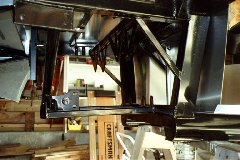 Here's the "cage"
at the rear of the frame in which the independent rear suspension
(aka IRS) will live. Here's the "cage"
at the rear of the frame in which the independent rear suspension
(aka IRS) will live.
Currently
most FFR Roadsters with the IRS option have their cages bolted
or welded in by the kit builder after the original build (as
a live axle car).
However,
since we were able to order the IRS as an option on our new kit,
the factory welded in the IRS cage and omitted the mounts for
the live axle links and springs. |
|
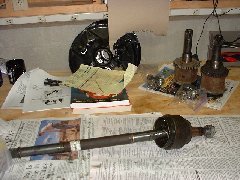 Our halfshafts, spindles,
and brakes come from a '91 Thunderbird. Our halfshafts, spindles,
and brakes come from a '91 Thunderbird.
The T-bird
halfshafts are too long for the narrower Cobra, so we had to
remove the CV joints from the T-bird shafts and install them
on shorter shafts that come with the IRS kit from FFR.
This was
a messy, thankless job. First we removed the larger joints (called
the "plunge joints"). These came off relatively easily,
even their inner pieces, which fit tightly to the shafts. You
can see these parts at the upper right, to the right of the brake
backing plates. |
|
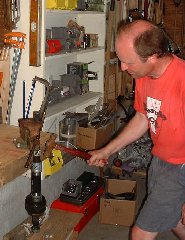 The smaller joints were not
so easy. The FFR manual said to tap the joints off with a hammer.
We hit them pretty darn hard, and they didn't budge. The smaller joints were not
so easy. The FFR manual said to tap the joints off with a hammer.
We hit them pretty darn hard, and they didn't budge.
This prompted
our first call to tech support. FFR engineer Jim Schenck said
that they sometimes use a tube around the shaft to make this
easier.
Here you
can see Nate using Hine-Pennington Racing special tool no. 00002,
made up of plumbing parts from the local general store, to remove
a CV joint. It worked great! |
|
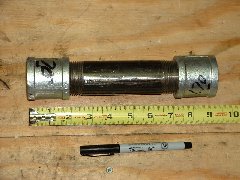 By special request, here's
another view of Hine-Pennington Racing special tool no. 00002.
Nate made it out of plumbing parts from the local general store,
namely a piece of large diameter water pipe and two threaded
unions. By special request, here's
another view of Hine-Pennington Racing special tool no. 00002.
Nate made it out of plumbing parts from the local general store,
namely a piece of large diameter water pipe and two threaded
unions.
The ruler
and pen are for size reference. |
|
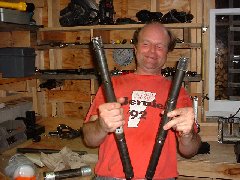 Finally Nate can display the
old and new halfshafts side by side, naked! No wonder he's smiling! Finally Nate can display the
old and new halfshafts side by side, naked! No wonder he's smiling!
The T-bird
shaft is on the left, and the new Cobra shaft is on the right. |
|
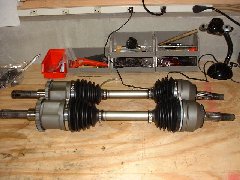 Here are the completed halfshafts,
looking wonderful in their new coats of paint, with the new rubber
boots supplied by FFR. Here are the completed halfshafts,
looking wonderful in their new coats of paint, with the new rubber
boots supplied by FFR.
Inside the
boots is a rather slimy mess, because the joints are filled with
a grease to keep them from burning up under the massive power
of the mighty Mustang 302. But we can't see that; only Nate had
to look at it!
Incidentally,
for some reason one of the clamps for the boots was missing,
and Nate misplaced another, but he was able to find generic replacements
for them (intended for a front wheel drive car, of course!) at
a local parts store. |
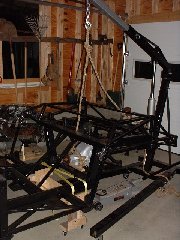 Well, now that we have halfshafts,
we need something to put them in. Here the differential gets
raised into the chassis, using the hoist above and floor jack
below. Well, now that we have halfshafts,
we need something to put them in. Here the differential gets
raised into the chassis, using the hoist above and floor jack
below. |
|
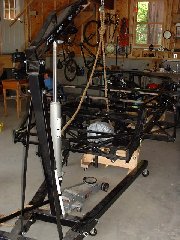 Here's another view. Here's another view.
This was
a tough job, because the differential barely fits through the
IRS cage. It had to go up with its nose up, twist, go up some
more, and then rotate into place.
It didn't
escape without getting a few scars on its fancy new paint job! |
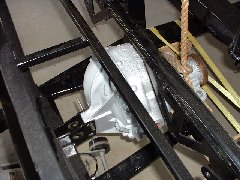 Finally the differential nestles
into its new home. I'll bolt it in later, after I've bought some
bolts that fit through the holes in the chassis. Finally the differential nestles
into its new home. I'll bolt it in later, after I've bought some
bolts that fit through the holes in the chassis. |
|
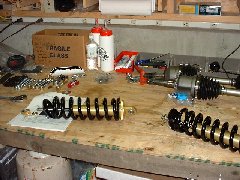 Three of the
four rear control arms arrived on Monday, July 10. Frustratingly,
one of the upper control arms was incexplicably left out! Three of the
four rear control arms arrived on Monday, July 10. Frustratingly,
one of the upper control arms was incexplicably left out!
We went ahead
and assembled as much as we could. At right are the springs,
dampers, halfshafts, and assorted other components that will
go into the rear suspension. |
|
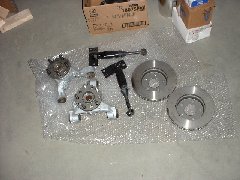 Here are more
components for the rear suspension. Here are more
components for the rear suspension.
At left are
the aluminim spindles from the Thunderbird, looking almost new
after we cleaned them up and Nate painted them with Eastwood
Alumablast.
At right
are the new Thunderbird discs, and in the middle are the "quad
shocks" from the Mustang.
The quad
shocks dampen rotational and longitudinal flexing of the rear
suspension assembly under acceleration and braking, helping to
prevent wheel hop. |
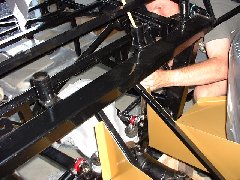 Here Nate is tightening the
bolts holding the long-awaited left lower control arm in place. Here Nate is tightening the
bolts holding the long-awaited left lower control arm in place. |
|
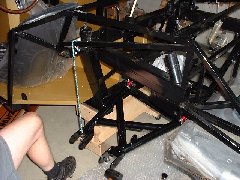 Here's the control arm, installed! Here's the control arm, installed!
The bungee
at left is holding up the control arm so it won't drop down too
far and hit the frame at the inboard end, near the inboard rod
ends.
Oops!
In this picture, the control arm is upside down and on the wrong
side. The tabs for the spring/damper unit need to be on the bottom.
Doh!
There's
a brief note to this effect in the IRS instructions, but in our
eagerness to install the long-awaited parts, we overlooked that
note. A call to FFR engineer Jim Schenck quickly resolved the
problem. Of course, now Jim probably thinks we're totally out
to lunch! |
|
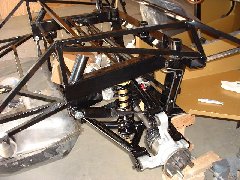 Here's the right side with
the upper control arm, spindle, halfshaft, and spring/damper
unit installed. Here's the right side with
the upper control arm, spindle, halfshaft, and spring/damper
unit installed.
Also note
the quad shock, connected to the frame at the left and angling
forward to its mounting tabs on the bottom of the upper control
arm.
The instructions
said to mount the quad shocks with their bodies forward, but
that produced tight clearances between them and the coil springs.
After discussion with factory engineers, we decided to mount
them with the bodies to the rear.
If they don't
clear the tires, we'll have to reverse them. |
|
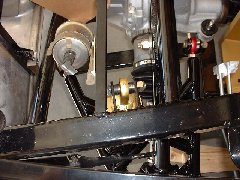 Here's a top view of the right
rear suspension. You can see the gold anodized top of the damper,
as well as the halfshaft with the inner CV joint (the "plunge"
joint) and rubber boot below it. Here's a top view of the right
rear suspension. You can see the gold anodized top of the damper,
as well as the halfshaft with the inner CV joint (the "plunge"
joint) and rubber boot below it.
The big can
at left is the fuel filter. At right you can se the fuel lines
(a main line and a smaller return line). These will soon be connected
to the fuel filter and the fuel tank (at far left) by some increadibly
expensive ($6 per foot!) high pressure flexible fuel lines. |
|
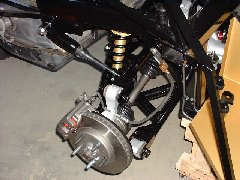 Now the brake disc and caliper
have been installed onto the spindle. Now the brake disc and caliper
have been installed onto the spindle.
Nate has
also mounted the inboard end of the brake line to the frame.
Don't worry;
the brake line isn't being stretched. Nate checked! Remember,
right now the suspension is at full droop; when the car is sitting
on its wheels, there will be considerable slack in the line. |
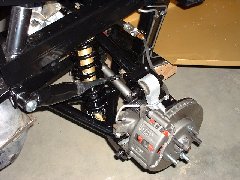 Here's another view of the
right rear suspension, this time from the rear quarter. Doesn't
it look cool? Here's another view of the
right rear suspension, this time from the rear quarter. Doesn't
it look cool? |
|
As soon as that
last upper link arrives, we'll finish installing the left side
and it will become a mirror image of this. |